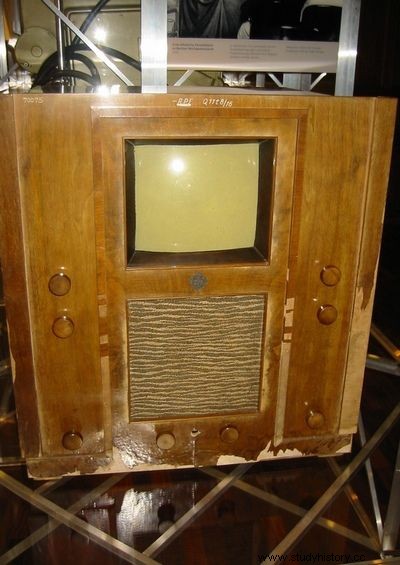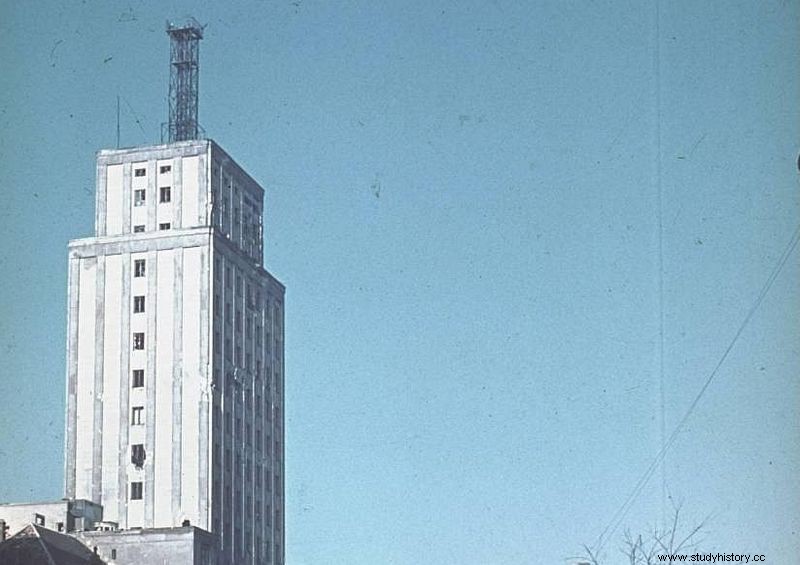Nowadays, almost every home has a TV set. Digital platforms and cable networks offer hundreds of channels with something for everyone. And even if not, he'll always be left jumping between programs. It is like that today, but you probably did not know that our grandparents in the interwar period could also enjoy the benefits of the glass screen.
It is believed that the beginning of television in Poland dates back to 1952. It was then that the experimental television studio was established, which broadcast the first half-hour program on October 25th.
However, we should look for the roots of the eleventh muse in our country much earlier. Already in 1929, Eng. Stefan Manczarski patented The Way TV image transfer via wire and radios (Patent No. 11084).

Telefunken television set from 1936. It was for such a miracle of technology that in pre-war Poland we had to pay 5,000 zlotys (photo:Eirik Newth; license CC BY-SA 2.0).
Put simply, the engineer constructed a transmitter and a television receiver. The diagonal of the screen was only a few centimeters and the image was not clear, but there was something to start with.
The idea caught the attention of the Ministry of Posts and Telegraphs (MPiT) and bought the patent. The device was then presented during the General National Exhibition in Poznań in the MPiT pavilion on May 16-25, 1929.
The next step was the tests carried out two years later in Katowice. In the local Polish Radio center, Edward Twardow and Fryderyk Dyrna constructed devices for transmitting television signals.
After all, the image quality left a lot to be desired this time as well. To make matters worse, in the era of the raging Great Depression, there were no sponsors ready to spend enough cash to conduct further research and the project died a natural death.
From patent to hardware
The real breakthrough came only in 1935, when the Television Department was established at the State Telecommunications Institute in Warsaw. It was headed by Eng. Lesław Kędzierski.
Thanks to the tests, in 1936, the construction of a device enabling the broadcasting of cinematographic films began. It was to be used on the Experimental Television Station.

As early as 1938, an antenna (perfectly visible in the photo taken in 1939) was erected on the roof of the Prudential in Warsaw, which was to transmit a television signal.
Also Polish Radio was not idle. In 1937, a television cell was established, headed by MSc. Władysław Cetner. One of its tasks was to construct image and sound transmitters for a TV station to be built in the capital.
Now is the time to build a transmitting antenna. It fell on the Warsaw building of the Prudential Insurance Company. Dziennik Poranny of June 8, 1938 reported this undertaking as follows:
On the roof of the top 17 story [17-story, there were 16 floors - editor's note of the author of the article] a skyscraper in Warsaw, at Napoleon Square, workers have been working for several weeks on erecting a steel mast structure. It will be a 28-meter tower of the first Polish TV station of Polish Radio.
The TV room is now fully assembled on the top floor of the building. The transmitting apparatus has already been tried. So that the TV station can start at any time.
However, since the TV studio and the receiver have not yet been finished, the issue of launching the station is delayed (…) .
Here comes the war ... and television
Indeed, it took several months for the first broadcast. It took place on October 5, and during it, the film "Barbara Radziwiłłówna" and a short performance by Mieczysław Fogg were shown. The range of the TV signal was about 20 kilometers. The program was only a test program, moreover, at that time in Warsaw probably no one had a private TV set.
There is no reason to be surprised, because tele-superheterodyne with an electric eye (that was the name of the TV set then), in 1938 cost about 5,000. zlotys. For comparison, the monthly salary of the captain of the Polish Army, supporting the family (basic salary), was 400 zlotys, of the brigadier's one thousand zlotys, and the marshal's 3,000 zlotys.
It must be remembered that after 1926, officer salaries were among the highest in the country. For 5 thousand. PLN, you could buy a little-used Polish Fiat 508, and adding another just over 2.5 thousand. PLN a new 1938 Chevrolet.
Before anyone could start considering spending a fortune on electric-eye tele-superheterodyne, however, a permanent program had to be launched.

A temporary "mobile studio" of Polish television for the 2nd Annual Radio Exhibition in the YMCA building. It was from there that the first official Polish TV program was broadcast.
The first official broadcast took place on August 26, 1939, during the opening of the second Annual Radio Exhibition. As Przemysław Semczuk states in his article "Forgotten jubilee of TVP":
It shows a performance by actress Irena Zaleska and a propaganda film by Polish Radio, prepared especially for this occasion. It could be seen in three more places:at the headquarters of the Polish Radio at ul. Zielna, the State Telecommunications Institute at ul. Ratuszowa 11 and the Telecommunications Office at Poznańska. Thanks to this, the broadcast gained a public character .
The approaching war, however, prevented regular broadcasting, which was planned to start in 1940. The Prudential building and the antenna mast at its top were to play an important role during the Warsaw Uprising. This is where the white and red flag was hung on August 1, visible even from distant parts of the city.
Bibliography:
- "Dziennik Ostrowski", September 10, 1938.
- "Morning Diary", June 8, 1938.
- Concise Statistical Yearbook, 1939.
- We hang the flag "on the tip" of Warsaw !, "TVN Warszawa", August 1, 2009.
- Alina Karwowska-Lamparska, The development of radio and television , "Telecommunications and ICT" 2003, No. 3-4.
- Alina Karwowska-Lamparska, The Institute of Telecommunications - the cradle of Polish television , "Telecommunications and ICT" 2009, No. 3-4.
- Przemysław Semczuk, The forgotten anniversary of TVP , "Newsweek Polska" 2009, No. 35.
